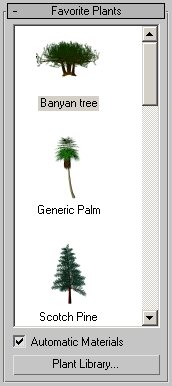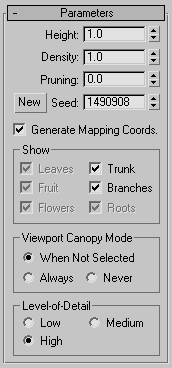Foliage produces various types of plant objects such as tree species. 3ds Max generates mesh representations to create fast, efficient, and good-looking plants.

You control height, density, pruning, seed, canopy display, and level of detail. The seed option controls creation of different representations of the same species. You can create millions of variations of the same species, so each object can be unique. With the viewport canopy mode option, you can control the amount of plant detail, reducing the number of vertices and faces 3ds Max uses to display the plant.

Some of the plants that can be created from the standard library
Tips
- Use the Spacing tool to place plants along a path.
- Use vertex or face snapping (see Snaps Settings) to position plants on a surface.

Using the Spacing tool to distribute trees along paths
Procedures
To add plants to a scene:
- Click the Favorite Plants rollout
 Plant Library button to display the Configure Palette dialog.
Plant Library button to display the Configure Palette dialog. - Double-click the row for each plant you want to add or remove from the Palette and click OK.
- On the Favorite Plants rollout, select a plant and drag it to a location in a viewport. Alternatively, select a plant in the rollout and then click in the viewport to place the plant.
- On the Parameters rollout, click the New button to display different seed variations of the plant.
- Adjust the remaining parameters to show elements of the plants, such as leaves, fruit, branches, and if you want, to view the plant in canopy mode.
Interface
Object Name and Wireframe Color rollout
This rollout lets you set the foliage object's name, color, and default material. For detailed information, see Object Name and Wireframe Color.
When Favorite Plants rollout  Automatic Materials is on, each plant is assigned its own default material. For more information, see Favorite Plants rollout, following.
Automatic Materials is on, each plant is assigned its own default material. For more information, see Favorite Plants rollout, following.
Keyboard Entry rollout
Favorite Plants rollout

The palette displays the plants currently loaded from the Plant Library. There are three ways to add a plant to the scene:
- Use keyboard entry.
- Click the icon in the Favorite Plants list and then click a location in a viewport. Double-click the icon to place the plant at the world origin.
- Drag the plant from the palette and drop it into a viewport.
- Automatic Materials
-
Assigns a default Multi Sub-Object material to the plant.
To modify the default material, you can use the Material Editor

 (Pick Material from Object) tool. See Pick Material from Object (Slate) or Pick Material From Object (Eyedropper) (Compact). Once you have picked the material, you can use the Material Editor to reassign sub-materials, change their settings, and so on.
(Pick Material from Object) tool. See Pick Material from Object (Slate) or Pick Material From Object (Eyedropper) (Compact). Once you have picked the material, you can use the Material Editor to reassign sub-materials, change their settings, and so on. If you turn off Automatic Materials, 3ds Max assigns no material to the object.
Note: Even if Automatic Materials is off, 3ds Max still assigns material IDs to the foliage sub-objects, so that the object is ready for a Multi/Sub-Object material. - Plant Library
-
Displays the Configure Palette dialog. Using this window, you can view information on the available plants including their names, whether they’re in the palette, their scientific names, types, descriptions, and the approximate number of faces per object. You can also add and remove plants from the palette, and clear the palette, which removes all plants from the palette.
Tip: To quickly add or remove a plant from the palette, double-click its row in the Configure Palette dialog. The Fav. (Favorite Plants) column entry switches between "no" and "yes." Click OK to accept the changes and exit the window.
Parameters rollout

- Height
-
Controls the approximate height of the plant. 3ds Max applies a random noise factor to the height of all of the plants. Therefore, the actual height of a plant, as measured in the viewports, won't necessarily match the setting given in the Height parameter.
- Density
-
Controls the amount of leaves and flowers on the plant. A value of 1 displays a plant with all its leaves and flowers, .5 displays a plant with half its leaves and flowers, and 0 displays a plant with no leaves or flowers.

Two trees with varying foliage densities
- Pruning
-
Applies only to plants with branches. Removes branches that lie below an invisible plane parallel to the construction plane. A value of 0 prunes nothing, a value of 0.5 prunes the plant at a plane halfway up its height from the construction plane, and a value of 1 prunes everything possible from the plant. What 3ds Max prunes from the plant depends on the type of plant. The trunk is never pruned.

Three pairs of trees, showing different values of pruning
- New
-
Displays a random variation of the current plant. 3ds Max displays the seed value in the numeric field next to the button.
Tip: Click the New button repeatedly until you find the variation you want. This is often easier than trying to adjust the tree using modifiers. - Seed
-
A value between 0 and 16,777,215 representing the possible variations of branch and leaf placement and shape and angle of the trunk of the current plant.
- Generate Mapping Coords
-
Applies default mapping coordinates to the plant. Default=on.
Show group

Controls the display of leaves, fruit, flowers, trunk, branches, and roots of plants. Available options depend on the type of plant you select. For example, if a plant doesn’t have fruit, 3ds Max disables that option. Turning off options reduces the number of vertices and faces displayed.
Viewport Canopy Mode group

In 3ds Max, the canopy of a plant is a shell covering the outermost parts of the plant, such as the leaves or the tips of the branches and trunk. The term derives from "forest canopy." Use reasonable parameters when you create many plants and want to optimize display performance.
Because this setting applies only to the plant's representation in the viewports, it has no effect on how 3ds Max renders the plant. For information on how 3ds Max renders the plant, see Level-of-Detail.
- When Not Selected Displays the plant in canopy mode when it’s not selected.
- Always Always displays the plant in canopy mode.
- Never Never displays the plant in canopy mode. 3ds Max displays all the features of the plant.
Level-of-Detail group

Controls how 3ds Max renders the plant. For information on how 3ds Max displays the plant in the viewports, see Viewport Canopy Mode.
- Low Renders the plant canopy, providing the lowest level of detail.
- Medium Renders a reduced-face-count version of the plant. How 3ds Max reduces the face count varies from plant to plant, but it usually involves removing smaller elements of the plant or reducing the number of faces in the branches and trunk.
- High Renders all the faces of the plant, providing the highest level of detail.